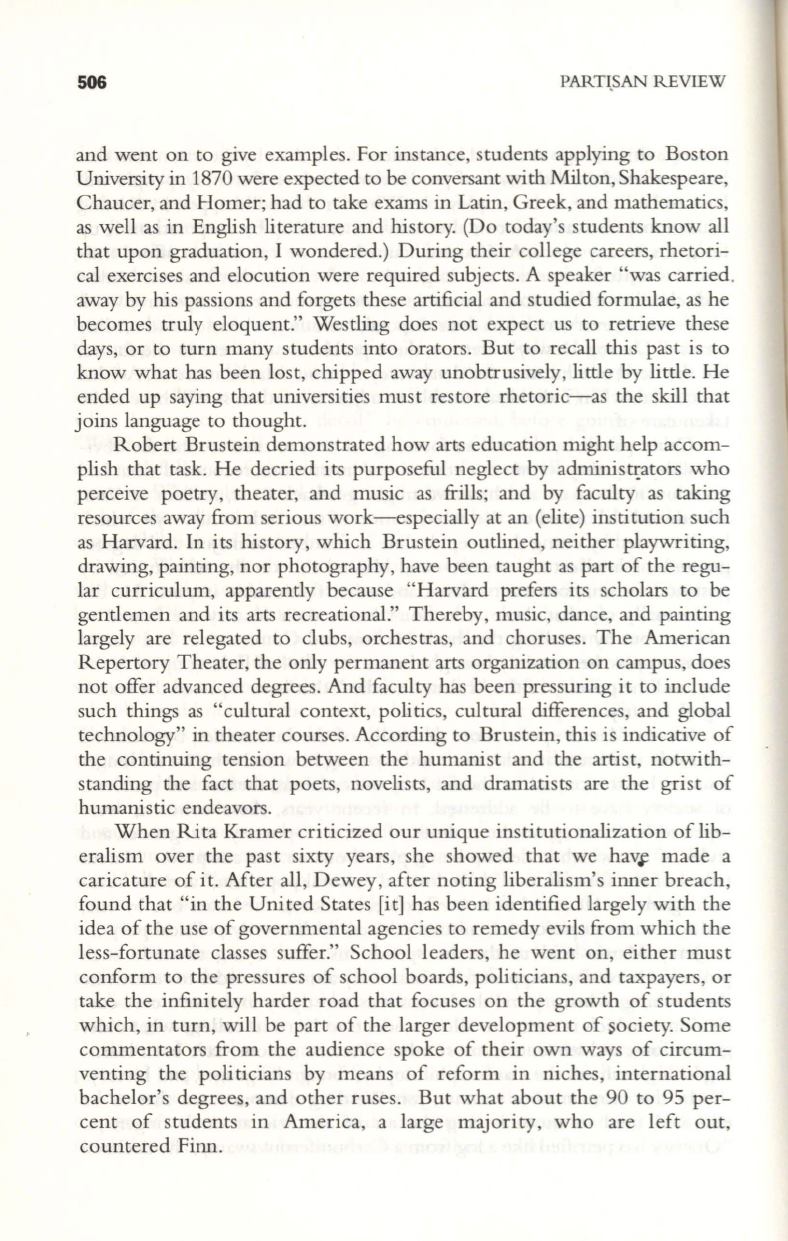
506
PARTI.SAN REVIEW
and went on to give examples. For instance, students applying to Boston
University in 1870 were expected to be conversant with Milton, Shakespeare,
Chaucer, and Homer; had to take exams in Latin, Greek, and mathematics,
as well as in English literature and history. (Do today's students know all
that upon graduation, I wondered.) During their college careers, rhetori–
cal exercises and elocution were required subjects. A speaker "was carried.
away by his passions and forgets these artificial and studied formulae, as he
becomes truly eloquent." Westling does not expect us to retrieve these
days, or to turn many students into orators. But to recall this past is to
know what has been lost, chipped away unobtrusively, little by little. He
ended up saying that universities must restore rhetoric-as the skill that
joins language to thought.
Robert Brustein demonstrated how arts education might help accom–
plish that task. He decried its purposeful neglect by
adrninist~ators
who
perceive poetry, theater, and music as frills; and by faculty as taking
resources away from serious work-especially at an (elite) institution such
as Harvard. In its history, which Brustein outlined, neither playwriting,
drawing, painting, nor photography, have been taught as part of the regu–
lar curriculum, apparently because "Harvard prefers its scholars to be
gentlemen and its arts recreational." Thereby, music, dance, and painting
largely are relegated to clubs, orchestras, and choruses. The American
Repertory Theater, the only permanent arts organization on campus, does
not offer advanced degrees. And faculty has been pressuring it to include
such things as "cultural context, politics, cultural differences, and global
technology" in theater courses. According to Brustein, this is indicative of
the continuing tension between the humanist and the artist, notwith–
standing the fact that poets, novelists, and dramatists are the grist of
humanistic endeavors.
When Rita Kramer criticized our unique institutionalization oflib–
eralism over the past sixty years, she showed that we hav; made a
caricature of it. After all, Dewey, after noting liberalism's inner breach,
found that "in the United States [it] has been identified largely with the
idea of the use of governmental agencies to remedy evils from which the
less-fortunate classes suffer." School leaders, he went on, either must
conform to the pressures of school boards, politicians, and taxpayers, or
take the infinitely harder road that focuses on the growth of students
which, in turn, will be part of the larger development of society. Some
commentators from the audience spoke of their own ways of circum–
venting the poli ticians by means of reform in niches, international
bachelor's degrees, and other ruses. But what about the 90 to 95 per–
cent of students in America, a large majority, who are left out,
countered Finn.


